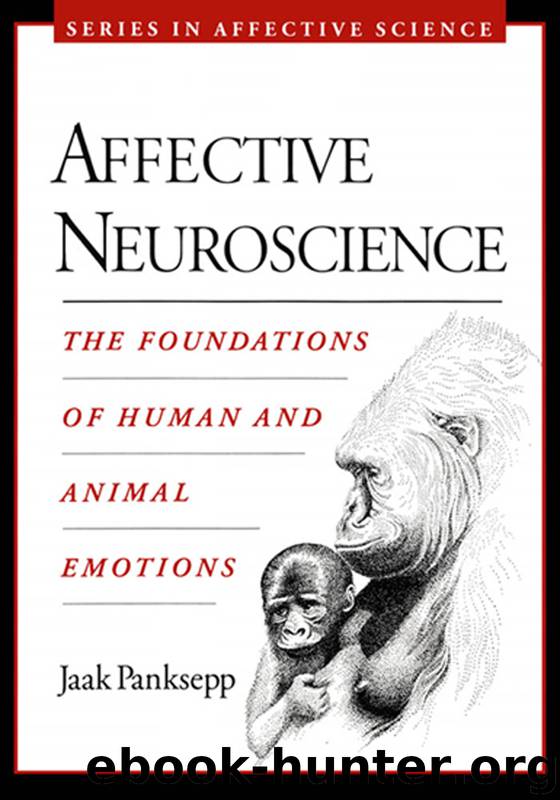Affective Neuroscience by Panksepp Jaak;

Author:Panksepp, Jaak;
Language: eng
Format: epub
Publisher: Oxford University Press, Incorporated
Published: 1998-11-08T16:00:00+00:00
Female and Male Sexual Behaviors: The Activational Phase
The imprint that is made on male and female fetal brains by early hormonal tides is finally developed at puberty (Figure 12.4). The passionate potentials of the nervous system are brought to life by renewed tides of hormone secretion. When animals copulate, neurons in widespread areas of the brain “light up,” as seen through Fos immunocytochemistry. The areas are widespread in medial subcortical zones, but especially in areas that have high concentrations of hormone receptors.63 These brain areas manufacture transmitters, partly under the control of sex hormones, that are especially important for normal sexuality. Obviously, a multiplicity of controls—emotional, cognitive, behavioral, and physiological—must be synchronized for competent sexual behavior in both males and females. Thus, scientific progress in this area will arise from our ability to follow and quantify these various components objectively, rooting out pervasive methodological problems, not to mention cultural biases. This makes the relevant human research remarkably difficult.
The most evident features of sexuality are behavioral, and excellent techniques exist to study the appetitive (proceptive) and consummatory (receptive) aspects of sexual behavior in lower animals. Accordingly, my focus here will be largely on the behavior of laboratory rats. However, we must remember that even in the brain research laboratory, much more work has been devoted to the consummatory (i.e., copulatory) components than to the proceptive, courting, or appetitive components of sexual behavior. Even more regrettably, more empirical work has been done on male than female sexual proclivities, and hence our factual coverage will remain a bit lopsided. This sex bias in the questions being asked has gradually been changing as increasing numbers of female investigators have entered this field of inquiry.
In general, experienced male rats housed alone in their cages are always ready for a little sex. Females, on the other hand, are not. Female rats typically have four-day sexual (estrus) cycles, and only for several hours on the day of estrus are they willing to participate in copulation. Nature has assured, for most species, that sexual arousal in females is tightly coordinated with peak fertility.
A few species, including humans, exhibit no such correspondence, and human females can remain receptive throughout the monthly cycle. In other words, human females exhibit a “concealed ovulation” with no clear “estrus cycle,” which makes sexual behavior around the peak of the monthly cycle a less probable event than it is in most other species. This means that sexual urges and the likelihood of fertilization have been dissociated to a substantial extent in our species, which may help promote male investment and pair-bonding with individual women. In other words, a human male cannot identify which female is ovulating by any external sign. Hence, for reproductive success, he needs to be more attentive to one female’s needs for longer periods of time than is characteristic of most mammals.64
If a human female is willing to offer sufficient sexual gratification to one male, the probability that he will squander or invest his resources elsewhere is reduced. This would obviously set female sexuality in humans apart from that found in most other species.
Download
This site does not store any files on its server. We only index and link to content provided by other sites. Please contact the content providers to delete copyright contents if any and email us, we'll remove relevant links or contents immediately.
| Administration & Medicine Economics | Allied Health Professions |
| Basic Sciences | Dentistry |
| History | Medical Informatics |
| Medicine | Nursing |
| Pharmacology | Psychology |
| Research | Veterinary Medicine |
Periodization Training for Sports by Tudor Bompa(7914)
Why We Sleep: Unlocking the Power of Sleep and Dreams by Matthew Walker(6348)
Paper Towns by Green John(4785)
The Immortal Life of Henrietta Lacks by Rebecca Skloot(4248)
The Sports Rules Book by Human Kinetics(4072)
Dynamic Alignment Through Imagery by Eric Franklin(3914)
ACSM's Complete Guide to Fitness & Health by ACSM(3818)
Kaplan MCAT Organic Chemistry Review: Created for MCAT 2015 (Kaplan Test Prep) by Kaplan(3796)
Introduction to Kinesiology by Shirl J. Hoffman(3621)
Livewired by David Eagleman(3531)
The River of Consciousness by Oliver Sacks(3414)
The Death of the Heart by Elizabeth Bowen(3333)
Alchemy and Alchemists by C. J. S. Thompson(3292)
Descartes' Error by Antonio Damasio(3162)
Bad Pharma by Ben Goldacre(3091)
The Gene: An Intimate History by Siddhartha Mukherjee(2925)
The Emperor of All Maladies: A Biography of Cancer by Siddhartha Mukherjee(2921)
The Fate of Rome: Climate, Disease, and the End of an Empire (The Princeton History of the Ancient World) by Kyle Harper(2863)
Kaplan MCAT Behavioral Sciences Review: Created for MCAT 2015 (Kaplan Test Prep) by Kaplan(2814)
